Artist Harry Koyama
Passion Re-Ignited
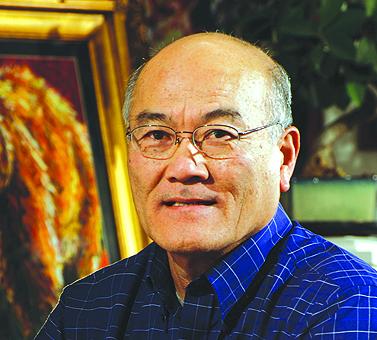
For as long as he can remember, Harry Koyama has considered himself an “artist-in-waiting.” On a Bozeman gallery walk in 2003, Harry had an epiphany. Something he saw sparked a long dormant passion for painting, discovered in college but never pursued. As he puts it, “My passion for art was re-ignited.” He went home, got out his easel, and hasn’t quit painting since.
“I pinch myself every day,” Harry said. “I never thought I’d put spaghetti on the table doing what I love!” A man with a gentle countenance, an easy laugh, and a contented spirit, Harry’s colorful grizzlies, elk, moose, American Indian dancers, and landscapes are in fine galleries and collections throughout the west. In 2011, he was invited to the juried Western Masters Art Show and Sale.
I first met Harry early in his full time artist’s life in a quaint lobby-studio of the old Hotel Becker on Hardin’s Main Street. Harry grew up in Hardin and got a degree in art from Montana State University-Billings. After college, Harry farmed the family sugar beet operation with two brothers near Hardin and did commissioned metal sculpture in the winter months.
“Art,” said Harry Koyama “was never far away.”
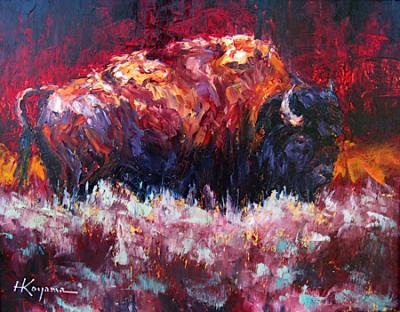
Power of Forgiveness
Ben Steele, a Professor Emeritus of Art at Montana State University-Billings, remembers the day young Harry Koyama walked into his art class at MSU-Billings in the mid-1960s. Steele, a WWII Bataan Death March survivor, thought he saw a “ghost” when Harry appeared. When he began working with the talented young man of Japanese descent, one of the “best in the class,” Steele said his animosities just “melted away.”
Harry didn’t know of his role in his professor’s life journey until he read the recent best-seller about Steele and other Bataan survivors by Michael and Elizabeth M. Norman, Tears of Darkness (New York: Farrar, Straus and Giroux, 2009).
Harry’s family was also adversely impacted by WWII. Harry’s grandfather, a Wyoming immigrant with the railroad in the early 1900’s, established a farming operation near Dunmore, just south of Hardin. Harry’s father, born in Sheridan, WY, left for California shortly before the war and married just days before Pearl Harbor. The young couple was sent to an internment camp in Gila, Arizona, after the war broke out. Early release allowed Harry’s father to oversee sugar beet operations near Hardin as part of the war effort.
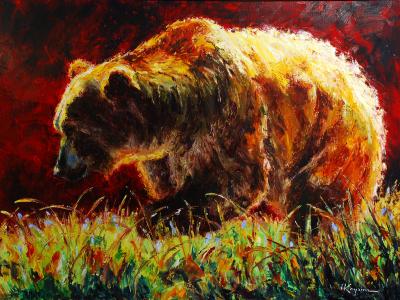
I can imagine Harry’s parents getting off the train at the old Hardin Depot after an arduous trip from Arizona. Maybe they had lunch or stayed the night in the Hotel Becker, the site of Harry’s Hardin studio, across from the depot, relieved to be away from the harsh conditions of the camps and hopeful about the life ahead of them.
“Then the rest of us came along!” Harry laughs about growing up in a family of seven siblings. When Harry talks of the internment camps, he emulates his mentor. There is no hint of lingering bitterness.
“We’ve become good friends,” said Harry of Ben Steele. “We meet monthly in an artists’ group where we potluck, share our work, and give one another feedback.” Then he laughed again. “We are stricken with the same affliction!”
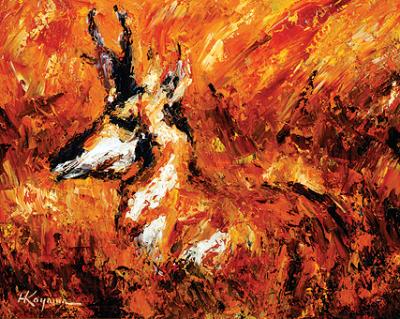
Settling in on Montana Avenue
Recently, Harry moved into chic digs on Billings’ historic Montana Avenue. His combined gallery and studio are on the main floor and a small apartment is on the second level. His new gallery is close to the Billings Depot, reminiscent of his Hardin studio. “These older buildings complement my work,” he observed.
The brush strokes in Harry’s recent paintings seem softer, his images are simpler. Earlier paintings had a sculpted look about them, which Harry attributes to his years as a metal sculptor.
“I’ve done my job if the painting evokes a sense of the grizzly bear, a moose, or a bison without every detail,” Harry said of his self-described “western impressionist” style. “That’s the trick—to reduce an image to its simplest form.” When I look at Harry’s animal subjects, I’m sure I’m looking directly at a large grizzly sow leading her cubs down a trail or feasting on mountain meadow huckleberries. Something in Harry’s painting triggers my imagination. I am there with the bear.
Looking around Harry’s studio recently, red was everywhere. Dark reds brew like a storm on the eastern Montana prairie behind a pronghorn antelope or they sear like a wildfire in Yellowstone National Park behind a massive buffalo. I think the red represents the re-ignited passion Harry feels for his craft and life in general. The chokecherry crimson and maroon red backgrounds don’t fit realistically, but they add an emotional dimension, part fascination and part fear, which allow one more avenue of access into the painting.
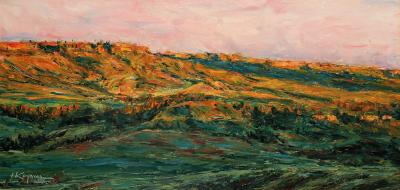
From Protégé to Philanthropist
It wasn’t long after Harry came to Billings when Ronald McDonald House asked him to create a special piece of art for their benefit auction. Now, he’s their signature artist. In addition to his original painting (which brings a tidy sum at auction), limited edition prints of the original are sold, as are Merry Wine Cellars merlot and chardonnays bearing labels with Koyama wildlife on them.
Harry is best known for his grizzly paintings. One large grizzly hangs in the University of Montana Adams Center. Another hangs in the Summit Hotel in Big Sky. But, when the Ronald McDonald House asked him to do a special painting for a Bozeman fundraiser, to be held in the heart of Bobcat Country, Harry was undeterred. Of his bobcat painted for the Bozeman festivities, he said wryly, “I am sure they will get it over there!”
There are many worthy charities,” noted Harry. “This one appeals to me. I am honored to help. I hear family stories first hand and I meet the children who are helped by the House. I get back much more than I give.” With characteristic humility, Harry’s taped thank you letters on a small space of gallery wall, all from organizations which have been recipients of his generosity, time and talent.
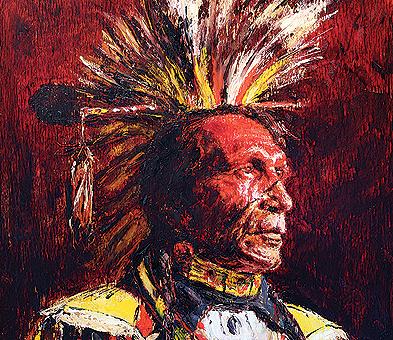
New Pathways
Harry and his wife, Sheri, often visit their two children in Los Angeles for what Harry calls “working vacations.” While their son is a USC graduate student in film production, their daughter operates a food truck vending business, aptly named “Auntie’s Fry Bread and Indian Tacos.” She learned the fine art of fry bread during summers at Hardin’s Little Big Horn Days, mentored by her auntie. On one of their last trips, Harry and Sheri worked the food truck near the Gene Autry Museum in Los Angeles.
“They line up for those Indian tacos!” Harry said, amused by his daughter’s clever career path in a place she loves.
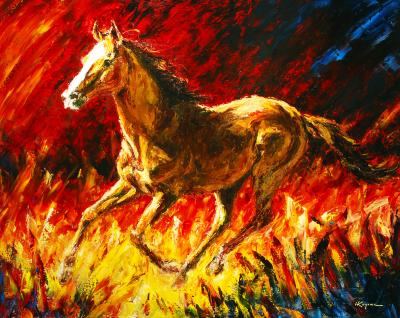
Just as his children’s lives are changing, Harry’s artist’s life is undergoing another metamorphosis. Explorations in design and color, without specific images, are challenging his artist’s sensibility. “I tried to do abstract paintings in college. I don’t think I had the maturity to think them through. They actually take more thought than those with a specific subject.”
“I must keep evolving,” he said. “I have to keep growing, as an artist and as a man, to survive and flourish.”
Virginia Bryan first met Harry Koyama when she was transitioning from lawyer to free-lance writer. During her days in the law, she considered herself to be a “writer-in-waiting.”
Leave a Comment Here
Leave a Comment Here